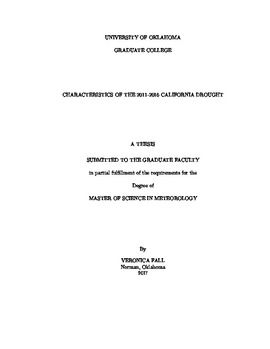| dc.contributor.advisor | Martin, Elinor | |
| dc.contributor.author | Fall, Veronica | |
| dc.date.accessioned | 2017-05-12T16:12:59Z | |
| dc.date.available | 2017-05-12T16:12:59Z | |
| dc.date.issued | 2017-05-13 | |
| dc.identifier.uri | https://hdl.handle.net/11244/50835 | |
| dc.description.abstract | The recent California drought persisted for five years from 2011-2016 and was the worst drought in recent memory. Previous studies have established that this drought was marked by low but not unprecedented rainfall coupled with extremely warm temperatures that acted to exacerbate the effects of reduced precipitation. Other studies analyzed how snow-water equivalent during the drought compares with California's historical records and the role teleconnections (El Ni\~no Southern Oscillation and the Pacific Decadal Oscillation) may have had to influence precipitation patterns across the state. This study analyzes maximum temperature, minimum temperature, and precipitation to compare with the findings of previous studies while specifically focusing on understanding how snowfall in the Sierra Nevada Mountains during the five years of drought from November through April compares with other five-year groups since 1950. It was found that 2011-2016 was the warmest five years for maximum temperature in California as well as the lowest snowfall in the mountains, which was significantly different from all other five-year groups since 1950. Snowfall exhibited strong oscillatory behavior significant for a cycle of 16 years with a secondary maximum between 2 and 4 years. These periods for snowfall were compared against ENSO and the PDO, where significant coherence was found with both teleconnections at periods between 3-4 years. It can be concluded that the California drought of 2011-2016 had the warmest maximum temperature on record since 1950 as well as the lowest snowfall in the Sierra Nevada Mountains and that the periodicity of ENSO and the PDO is coherent at short time scales with snowfall. Understanding how snowfall differed during the drought when compared to climatology will help to explain why runoff during these years was so low and why reservoir capacity was well below the historical average. | en_US |
| dc.subject | meteorology, climatology, drought | en_US |
| dc.title | Characteristics of the 2011-2016 California Drought | en_US |
| dc.contributor.committeeMember | Leslie, Lance | |
| dc.contributor.committeeMember | Richman, Michael | |
| dc.date.manuscript | 2017-05-12 | |
| dc.thesis.degree | Master of Science in Meteorology | en_US |
| ou.group | College of Atmospheric & Geographic Sciences::School of Meteorology | en_US |
| shareok.nativefileaccess | restricted | en_US |
